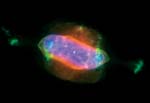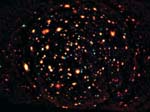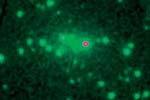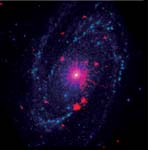XMM-Newton Ruler Images
Dying Star
 NGC
7009 is the glowing death-throes of a dying star. Thousands of years ago the
star, once much like the Sun, was reaching the end of its life. It started to
blow a slow, dense wind, like the solar wind. As the star aged further, the
wind it blew got faster. The fast wind caught up with the slower moving-gas
and collided with it. This cosmic train-wreck heated up the gas (called a "nebula"),
making it glow. It can also sculpt the gas into odd shapes; in this case the
ellipses and knots seen (making it obvious why NGC 7009 is nicknamed "the Saturn
Nebula"). The fast wind scoops up the slower wind, leaving behind a large cavity
surrounding the star. In the image, the red and green colors show the visible
light emitted by the relatively cool regions of gas, and the blue color represents
the X-rays from the very hot gas. Superimposed, they show that the inner cavity
is actually filled with hot gas, heated by the collision. The star itself can
be seen in the center.
NGC
7009 is the glowing death-throes of a dying star. Thousands of years ago the
star, once much like the Sun, was reaching the end of its life. It started to
blow a slow, dense wind, like the solar wind. As the star aged further, the
wind it blew got faster. The fast wind caught up with the slower moving-gas
and collided with it. This cosmic train-wreck heated up the gas (called a "nebula"),
making it glow. It can also sculpt the gas into odd shapes; in this case the
ellipses and knots seen (making it obvious why NGC 7009 is nicknamed "the Saturn
Nebula"). The fast wind scoops up the slower wind, leaving behind a large cavity
surrounding the star. In the image, the red and green colors show the visible
light emitted by the relatively cool regions of gas, and the blue color represents
the X-rays from the very hot gas. Superimposed, they show that the inner cavity
is actually filled with hot gas, heated by the collision. The star itself can
be seen in the center.
URL for more info: http://xmm.vilspa.esa.es/external/xmm_science/gallery/public/level3.php?id=244
Image courtesy of M.A. Guerrero, University of Illinois, USA and ESA
Visible light image: Hubble Space Telescope, taken by a team led by B. Balick
(University of Washington)
X-ray images: XMM-Newton, taken by a team led by Y.-H. Chu (University of Illinois)
Download High-Resolution Tiff: 1 MB
Gas Bubble
 The
Sun is a relatively stable, calm star, but not all stars are alike. Some, much
more massive than the Sun, are far hotter and more excitable. Among the most
spectacular are the Wolf-Rayet stars, which are near the theoretical limit for
how massive and hot stars can be without tearing themselves to pieces. These
stars blow off a violent stream of gas, which scoops up the gas around the star
like a snowshovel piling up snow, creating a giant bubble in space. The bubble
shown, called S308, is one such cavity carved out by the wind. The gas inside
the cavity is heated to tens of millions of degrees, and glows in X-rays. The
image on the left shows these X-rays coming from the shell of the bubble. The
image on the right shows the corresponding emission in optical light from cooler
gas. In X-rays alone, this bubble gives off about ten times as much energy as
the Sun does!
The
Sun is a relatively stable, calm star, but not all stars are alike. Some, much
more massive than the Sun, are far hotter and more excitable. Among the most
spectacular are the Wolf-Rayet stars, which are near the theoretical limit for
how massive and hot stars can be without tearing themselves to pieces. These
stars blow off a violent stream of gas, which scoops up the gas around the star
like a snowshovel piling up snow, creating a giant bubble in space. The bubble
shown, called S308, is one such cavity carved out by the wind. The gas inside
the cavity is heated to tens of millions of degrees, and glows in X-rays. The
image on the left shows these X-rays coming from the shell of the bubble. The
image on the right shows the corresponding emission in optical light from cooler
gas. In X-rays alone, this bubble gives off about ten times as much energy as
the Sun does!
http://xmm.vilspa.esa.es/external/xmm_science/gallery/public/level3.php?id=56
Image courtesy of Y-H.Chu (University of Illinois), R.A. Gruendl (San Diego
State University and University of Illinois) and ESA.
Download High-Resolution Tiff: 1.1 MB
XMM-Newton Satellite
 XMM-Newton
is an X-ray observatory built and launched as a joint venture of the United
States and European space agencies. You can read more about XMM-Newton at the
Observatory and Instruments
section of this site.
XMM-Newton
is an X-ray observatory built and launched as a joint venture of the United
States and European space agencies. You can read more about XMM-Newton at the
Observatory and Instruments
section of this site.
http://xmm.vilspa.esa.es/external/xmm_science/gallery/public/level3.php?id=276
Image courtesy of ESA
Download High-Resolution Tiff: 1.6 MB
Lockman's Hole
 Most
people think of space as empty, but in fact there can be quite a bit of gas
and dust particles floating around, which obscure the most distant objects in
the Universe. Sometimes, though, there can be a "clearing" of material, allowing
a better view. One such region is the "Lockman Hole", named after astronomer
F. Jay Lockman, who discovered it. Through this hole in the gas, the X-rays
from distant galaxies can reach the Earth relatively unobscured. This XMM-Newton
image is the total of nearly 100,000 seconds of exposure time (over a solid
day!), and shows more than 60 previously undetected sources of X-rays from the
early Universe. Each spot in the image is an entire galaxy, pouring out high-energy
X-rays, probably emitted as
matter falls into supermassive black holes.
Most
people think of space as empty, but in fact there can be quite a bit of gas
and dust particles floating around, which obscure the most distant objects in
the Universe. Sometimes, though, there can be a "clearing" of material, allowing
a better view. One such region is the "Lockman Hole", named after astronomer
F. Jay Lockman, who discovered it. Through this hole in the gas, the X-rays
from distant galaxies can reach the Earth relatively unobscured. This XMM-Newton
image is the total of nearly 100,000 seconds of exposure time (over a solid
day!), and shows more than 60 previously undetected sources of X-rays from the
early Universe. Each spot in the image is an entire galaxy, pouring out high-energy
X-rays, probably emitted as
matter falls into supermassive black holes.
http://xmm.vilspa.esa.es/external/xmm_science/gallery/public/level3.php?id=38
Image courtesy of G. Hasinger, MPE Garching, Germany and ESA.
Download High-Resolution Tiff: 1.3 MB
Andromeda galaxy
 The
famous Andromeda Galaxy is the nearest large spiral galaxy to our own Milky
Way. Although it appears as just a smudge to the naked eye or through binoculars,
it is actually a mighty collection of hundreds of billions of stars. Centered
on the nucleus of the Andromeda Galaxy, this XMM-Newton image covers an area
of the sky about the size of the full Moon. Over 100 sources of X-rays can be
seen, including neutron stars, black holes, exploding stars, and binary stars.
The
famous Andromeda Galaxy is the nearest large spiral galaxy to our own Milky
Way. Although it appears as just a smudge to the naked eye or through binoculars,
it is actually a mighty collection of hundreds of billions of stars. Centered
on the nucleus of the Andromeda Galaxy, this XMM-Newton image covers an area
of the sky about the size of the full Moon. Over 100 sources of X-rays can be
seen, including neutron stars, black holes, exploding stars, and binary stars.
http://xmm.vilspa.esa.es/external/xmm_science/gallery/public/level3.php?id=41
Image courtesy of S. Trudolyubov and ESA.
Download High-Resolution Tiff: 1.4 MB
Galaxy M81
 M81
is another relatively nearby spiral galaxy in the constellaion of Ursa Major.
In this image, the blue and green regions are from ultraviolet sources, which
is mostly from hot young stars. This indicates sites of star formation (since
the stars are young), and traces the spiral arms of the galaxy. The red regions
are from X-ray emitting sources. The bright emission from the center is thought
to originate from a supermassive black hole that is slowly eating the matter
around it. As the matter falls into that bottomless pit, it heats up to millions
of degrees and glows in X-rays. This image is a combination of images from the
XMM-Newton Optical Monitor (which is sensitive to ultraviolet light as well)
and the X-ray Telescope.
M81
is another relatively nearby spiral galaxy in the constellaion of Ursa Major.
In this image, the blue and green regions are from ultraviolet sources, which
is mostly from hot young stars. This indicates sites of star formation (since
the stars are young), and traces the spiral arms of the galaxy. The red regions
are from X-ray emitting sources. The bright emission from the center is thought
to originate from a supermassive black hole that is slowly eating the matter
around it. As the matter falls into that bottomless pit, it heats up to millions
of degrees and glows in X-rays. This image is a combination of images from the
XMM-Newton Optical Monitor (which is sensitive to ultraviolet light as well)
and the X-ray Telescope.
http://xmm.vilspa.esa.es/external/xmm_science/gallery/public/level3.php?id=250
Image courtesy of A. Breeveld, M.S.S.L. and RGS Consortium and ESA
Download High-Resolution Tiff: 850 KB
 NGC
7009 is the glowing death-throes of a dying star. Thousands of years ago the
star, once much like the Sun, was reaching the end of its life. It started to
blow a slow, dense wind, like the solar wind. As the star aged further, the
wind it blew got faster. The fast wind caught up with the slower moving-gas
and collided with it. This cosmic train-wreck heated up the gas (called a "nebula"),
making it glow. It can also sculpt the gas into odd shapes; in this case the
ellipses and knots seen (making it obvious why NGC 7009 is nicknamed "the Saturn
Nebula"). The fast wind scoops up the slower wind, leaving behind a large cavity
surrounding the star. In the image, the red and green colors show the visible
light emitted by the relatively cool regions of gas, and the blue color represents
the X-rays from the very hot gas. Superimposed, they show that the inner cavity
is actually filled with hot gas, heated by the collision. The star itself can
be seen in the center.
NGC
7009 is the glowing death-throes of a dying star. Thousands of years ago the
star, once much like the Sun, was reaching the end of its life. It started to
blow a slow, dense wind, like the solar wind. As the star aged further, the
wind it blew got faster. The fast wind caught up with the slower moving-gas
and collided with it. This cosmic train-wreck heated up the gas (called a "nebula"),
making it glow. It can also sculpt the gas into odd shapes; in this case the
ellipses and knots seen (making it obvious why NGC 7009 is nicknamed "the Saturn
Nebula"). The fast wind scoops up the slower wind, leaving behind a large cavity
surrounding the star. In the image, the red and green colors show the visible
light emitted by the relatively cool regions of gas, and the blue color represents
the X-rays from the very hot gas. Superimposed, they show that the inner cavity
is actually filled with hot gas, heated by the collision. The star itself can
be seen in the center. 



